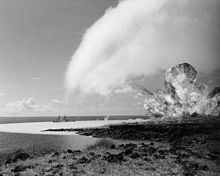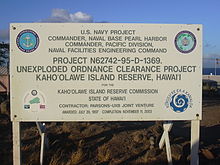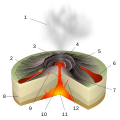- Kahoolawe
-
Kahoolawe The Target Isle 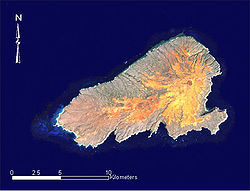
Landsat satellite image of Kahoolawe.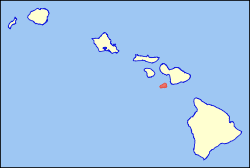
Geography Location 20°33′N 156°36′W / 20.55°N 156.6°W Area 44.6 sq mi (115.5 km²) Rank 8th largest Hawaiian Island Highest point Puʻu Moaulanui
on the crater rim of Lua MakikaMax elevation 1,483 ft (452 m)[1] Demographics Population Uninhabited Official Insignia Flower Hinahina kū kahakai (Heliotropium anomalum var. argenteum)[2] Color ʻĀhinahina (gray) Kahoolawe (
 /kəˌhoʊ.əˈlɑːwiː/; Hawaiian: [kəˈhoʔoˈlɐve]) is the smallest of the eight main volcanic islands in the Hawaiian Islands. Kahoolawe is located about seven miles (11.2 km) southwest of Maui and also southeast of Lanai, and it is 11 miles (18 km) long by 6.0 miles (9.7 km) wide, with a total land area of 44.6 square miles (115.5 km2).[3] The highest point on Kahoolawe is the crater of Lua Makika at the summit of Puʻu Moaulanui, which is about 1,477 feet (450 m) above sea level. Kahoolawe is relatively dry (average annual rainfall is less than 65 cm/26 in)[4] because the island's low elevation fails to generate much orographic precipitation from the northeastern trade winds, and Kahoolawe is located in the rain shadow of eastern Maui's 10,023 feet (3,055 m) high volcano, Haleakalā. More than one quarter of Kahoolawe has been eroded down to saprolitic hardpan soil.
/kəˌhoʊ.əˈlɑːwiː/; Hawaiian: [kəˈhoʔoˈlɐve]) is the smallest of the eight main volcanic islands in the Hawaiian Islands. Kahoolawe is located about seven miles (11.2 km) southwest of Maui and also southeast of Lanai, and it is 11 miles (18 km) long by 6.0 miles (9.7 km) wide, with a total land area of 44.6 square miles (115.5 km2).[3] The highest point on Kahoolawe is the crater of Lua Makika at the summit of Puʻu Moaulanui, which is about 1,477 feet (450 m) above sea level. Kahoolawe is relatively dry (average annual rainfall is less than 65 cm/26 in)[4] because the island's low elevation fails to generate much orographic precipitation from the northeastern trade winds, and Kahoolawe is located in the rain shadow of eastern Maui's 10,023 feet (3,055 m) high volcano, Haleakalā. More than one quarter of Kahoolawe has been eroded down to saprolitic hardpan soil.Kahoolawe has always been sparsely populated, due to its lack of fresh water.[5] During World War II, Kahoolawe was used as a training ground and bombing range by the Armed Forces of the United States. After decades of protests, the U.S. Navy ended live-fire training exercises on Kahoolawe in 1990, and the whole island was transferred to the jurisdiction of the State of Hawaii in 1994. The Hawaii State Legislature established the Kahoolawe Island Reserve to restore and to oversee the island and its surrounding waters. Today Kahoolawe can be used only for native Hawaiian cultural, spiritual, and subsistence purposes.
The U.S. Census Bureau defines Kahoolawe as Block Group 9, Census Tract 303.02 of Maui County, Hawaii. Kahoolawe has no permanent residents.[6]
Contents
History
Settlement
Sometime around the year 1000, Kahoolawe was settled, and small, temporary fishing communities were established along the coast. Some inland areas were cultivated. Puʻu Moiwi, a remnant cinder cone,[7] is the location of the second-largest basalt quarry in Hawaii, and this was mined for use in stone tools such as koʻi (adzes).[8] Originally a dry forest environment with intermittent streams, the land changed to an open savanna of grassland and trees when inhabitants cleared vegetation for firewood and agriculture.[9] Hawaiians built stone platforms for religious ceremonies, set rocks upright as shrines for successful fishing trips, and carved petroglyphs, or drawings, into the flat surfaces of rocks. These indicators of an earlier time can still be found on Kahoolawe.
While it is not known how many people inhabited Kahoolawe, the lack of freshwater probably limited the population to a few hundred people. As many as 120 people might have once lived at Hakioawa, the largest settlement, which was located at the northeastern end of the island -- facing Maui.
Warfare
Violent wars among competing aliʻi (chiefs) laid waste to the land and led to a decline in the population. During the War of Kamokuhi, Kalaniʻōpuʻu, the ruler of the Big Island of Hawaii, raided and pillaged Kahoolawe in an unsuccessful attempt to take Maui from Kahekili II, the King of Maui.[10]
Post-contact
From 1778 to the early 19th century, observers on passing ships reported that Kahoolawe was uninhabited and barren, destitute of both water and wood. After the arrival of missionaries from New England, the Kingdom of Hawaii under the rule of King Kamehameha III replaced the death penalty with exile, and Kahoolawe became a men's penal colony sometime around 1830. Food and water were scarce, some prisoners reportedly starved, and some of them swam across the channel to Maui to find food. The law making the island a penal colony was repealed in 1853.
A survey of Kahoolawe in 1857 reported about 50 residents here, about 5,000 acres (20 km2) of land covered with shrubs, and a patch of sugarcane growth. Along the shore, tobacco, pineapple, gourds, pili grass, and scrub trees grew. Beginning in 1858, the Hawaiian government leased Kahoolawe to a series of ranching ventures. Some of these proved to be more successful than others, but the lack of freshwater was an unrelenting enemy. Through the next 80 years, the landscape changed dramatically, with drought and uncontrolled overgrazing denuded much of the island. Strong trade winds blew away most of the topsoil, leaving behind red hardpan dirt.
20th century
From 1910 to 1918, the Territory of Hawaii designated Kahoolawe as a forest reserve in the hope of restoring the island through a revegetation and livestock removal program. This program failed, and leases again became available. In 1918, the rancher Angus MacPhee of Whoming, with the help of the landowner Harry Baldwin of Maui, leased the island for 21 years, intending to build a cattle ranch there. By 1932, the ranching operation was enjoying moderate success. After heavy rains, native grasses and flowering plants would sprout, but droughts always returned. In 1941, MacPhee sublet part of the island to the U.S. Army. Later that year, because of continuing drought, MacPhee removed his cattle from the island.
Training grounds
On December 8, 1941, after the Imperial Japanese Navy attacked Pearl Harbor and Oahu, the U.S. Army declared martial law throughout Hawaii, and it used Kahoolawe as a place to train American soldiers and Marines headed west to engage in the War in the Pacific. The use of Kahoolawe as a bombing range was believed to be critical, since the United States was executing a new type of war in the Pacific Islands. Their success depended on accurate naval gunfire support that suppressed or destroyed enemy positions as U.S. Marines and soldiers struggled to get ashore. Thousands of soldiers, sailors, Marines, airmen, and coastguardsmen prepared on Kahoolawe for the brutal and costly assaults on islands such as the Gilbert and Marshall Islands, the Marianas and Pelileu, New Guinea, et cetera, in the Western Pacific.[citation needed]
Military and naval training on Kahoolawe continued following World War II. During the Korean War, warplanes from aircraft carriers played a critical role in attacking enemy airfields, convoys, and troop staging areas. Mock-ups of airfields, military camps, and vehicles were constructed on Kahoolawe, and while pilots were preparing for war at Barbers Point Naval Air Station on Oahu, they practiced spotting and hitting the mock-ups at Kahoolawe. Similar training took place throughout the Cold War and during the War in Vietnam, with mock-ups of aircraft, radar installations, gun mounts, and surface-to-air missile sites being placed across this island for pilots and bombardiers to use in their training.
In early 1965, the U.S. Navy conducted Operation Sailor Hat to determine the blast resistance of ships. Three tests off the coast of Kahoolawe subjected the island and a target ship to massive explosions, with 500 tons of conventional TNT detonated on the island near the target ship USS Atlanta (CL-104). This warship was damaged, but she was not sunk. The blasts created a crater on the island known as "Sailor Man's Cap" and they might have cracked the island's caprock, causing some groundwater to be lost into the ocean.[11]
Operation Protect Kahoolawe Ohana (PKO)
In 1976, a group of individuals calling themselves the Protect Kahoolawe Ohana (PKO) filed suit in U.S. Federal Court to stop the Navy's use of Kahoolawe for bombardment training, to require compliance with a number of new environmental laws and to ensure protection of cultural resources on the island. In 1977, the U.S. District Court for the District of Hawaii allowed the Navy's use of this island to continue, but the Court directed the Navy to prepare an environmental impact statement and to complete an inventory of historic sites on the island. On March 9, 1977, two PKO leaders, George Helm and Kimo Mitchell, were lost at sea during an attempt to occupy Kahoolawe in symbolic protest. In 1980, the Navy and the Protect Kahoolawe Ohana promulgated a consent decree that allowed continued naval training on the island, monthly access to the island for the PKO, surface clearance of part of the island (10,000 acres (40 km2)), soil conservation, the eradication of feral goats and an archaeological survey.[12]
Kahoolawe Island Archeological District
Kahoolawe Island Archeological DistrictNRHP Reference#: 81000205
[13]Added to NRHP: March 18, 1981 On March 18, 1981, the entire island of Kahoolawe was added to the National Register of Historic Places. At that time, the Kahoolawe Archaeological District was noted to contain 544 recorded archaeological or historic sites and over 2,000 individual features. As part of the soil conservation efforts, Mike Ruppe and other workers laid lines of explosives, detonating them to break the hardpan so that seedling trees could be planted. Used car tires were taken to Kahoolawe and placed in miles of deep gullies to slow the washing of red soil from the barren uplands to the surrounding shores. Ordinance and scrap metal was picked up by hand and then transported by large trucks to a collection site.[14]
End of live-fire training
In 1990, President George H. W. Bush ordered an end to live-fire training on the island. The U.S. Department of Defense Appropriations Act for Fiscal Year 1991 established the Kahoolawe Island Conveyance Commission to recommend terms and conditions for the conveyance of Kahoolawe from the U.S. Government to the Hawaii.
Transfer of title and UXO cleanup
In 1993, Senator Daniel Inouye of Hawaii sponsored Title X of the Fiscal Year 1994 for the Department of Defense appropriation bill, directing that the U.S. Government to convey Kahoolawe and its surrounding waters to the State of Hawaii. Title X also established the objective of a "clearance or removal of unexploded ordnance (UXO)" and the environmental restoration of the island, to provide "meaningful safe use of the island for appropriate cultural, historical, archaeological, and educational purposes, as determined by the State of Hawaii." [14] In turn, the Legislature of Hawaii created the Kahoolawe Island Reserve Commission to exercise policy and management oversight of the Kahoolawe Island Reserve. As directed by Title X and in accordance with a required Memorandum of Understanding between the U.S. Navy and the State of Hawaii, the Navy transferred the title to the land of Kahoolawe to the Hawaii on May 9, 1994.
As required by Title X, the U.S. Navy retained access control to the island until the clearance and environmental restoration projects were completed, or until November 11, 2003, whichever came first. The State agreed to prepare a Use Plan for Kahoolawe and the Navy agreed to develop a Cleanup Plan based on that use plan and to implement that plan to the extent Congress provided funds for that purpose.
In July 1997, the Navy awarded a contract to the Parsons / UXB Joint Venture to clear unexploded ordinance from the island to the extent funds were provided by Congress.[15] After the State and public review of the Navy cleanup plan, Parsons/UXB began their work on the island in November 1998.
From 1998 to 2003, the U.S. Navy, executed a large-scale, but limited, removal of unexploded ordnance and other environmental hazards from Kahoolawe.[16] Since the clearance did not completely remove all the hazardous and dangerous materials from the island, a residual level of danger remains. The Kahoolawe Island Reserve Commission developed a plan to manage the residual risk to reserve users and to carry out a safety program, and to establish stewardship organizations to work in conjunction with the commission.[16]
Kahoolawe Island Reserve
In 1993, the Hawaiian State Legislature established the Kahoolawe Island Reserve, consisting of "the entire island and its surrounding ocean waters in a two mile (three km) radius from the shore". By State Law, Kahoolawe and its waters can only be used for Native Hawaiian cultural, spiritual, and subsistence purposes; fishing; environmental restoration; historic preservation; and education. All commercial uses are prohibited.
The Legislature also created the Kahoolawe Island Reserve Commission to manage the Reserve while it is held in trust for a future Native Hawaiian Sovereignty entity. The restoration of Kahoolawe will require a strategy to control erosion, re-establish vegetation, recharge the water table, and gradually replace alien plants with native species. Plans will include methods for damming gullies and reducing rainwater runoff. In some areas, non-native plants will temporarily stabilize soils before planting of permanent native species. Species used for revegetation include ʻaʻaliʻi (Dodonaea viscosa), ʻāheahea (Chenopodium oahuense), kuluʻī (Nototrichium sandwicense), Achyranthes splendens, ʻūlei (Osteomeles anthyllidifolia), kāmanomano (Cenchrus agrimonioides var. agrimonioides), koaiʻa (Acacia koaia), and alaheʻe (Psydrax odorata).[17]
Traditional subdivisions
Traditionally, Kahoolawe has been an ahupua'a of Honua'ula (Makawao),[18] one of the twelve moku of the island (mokupuni) of Maui.,[19] and was subdivided into twelve `ili that were later combined to eight:[20][21] The eight ʻili are listed below, in counterclockwise sequence, and original area figures in acres, starting in the northeast:[22]
Nr. ʻili Area
acresArea
km²1 Hakioawa 2283 9.24 2 Pāpākā 1443 5.84 3 Kuheia-Kaulana 3429 13.88 4 Ahupū 4351 17.61 5 Honoko`a 1701 6.88 6 Kealaikahiki 3276 13.26 7 Kūnaka-Na`alapa 9626 38.96 8 Kanapou 2511 10.16 9 (Lua Makika) 156 0.63 Kahoʻolawe 28776 116.45 The boundaries of all but the two westernmost `ili converge on the crater rim of Lua Makika, but do not include it. The crater area of Lua Makika is not considered an `ili and does not belong to any `ili.
According to other sources, the island was subdivided into 16 ahupua'a that belonged to three moku, namely Kona, Ko’olau and Molokini.[23]
See also
- Alalakeiki Channel
- National Register of Historic Places listings in Hawaii#Kahoolawe
- Vieques, Puerto Rico
References
- ^ "Table 5.11 - Elevations of Major Summits" (PDF). 2004 State of Hawaii Data Book. State of Hawaii. 2004. http://www.hawaii.gov/dbedt/info/economic/databook/db2004/section05.pdf. Retrieved 2007-07-23.
- ^ Shearer, Barbara Smith (2002). "Chapter 6 - State and Territory Flowers". State Names, Seals, Flags, and Symbols: a Historical Guide (3 ed.). Greenwood Publishing Group. p. 99. ISBN 9780313315343. http://books.google.com/?id=nCA0UuGlJG8C.
- ^ "Table 5.08 - Land Area of Islands: 2000" (PDF). 2004 State of Hawaii Data Book. State of Hawaii. 2004. http://www.hawaii.gov/dbedt/info/economic/databook/db2004/section05.pdf. Retrieved 2007-07-23.
- ^ "Kahoolawe". Hawaii's Comprehensive Wildlife Conservation Strategy. Hawaii Division of Land and Natural Resources. http://www.state.hi.us/dlnr/dofaw/cwcs/files/NAAT%20final%20CWCS/Chapters/CHAPTER%206%20kahoolawe%20NAAT%20final%20!.pdf.
- ^ Robert C. Schmitt and Carol L. Silva: Population Trends on Kahoolawe
- ^ Block Group 9, Census Tract 303.02, Maui County United States Census Bureau
- ^ Macdonald, Gordon Andrew; Agatin Townsend Abbott; Frank L. Peterson (1983). Volcanoes in the Sea: the Geology of Hawaii (2 ed.). University of Hawaii Press. p. 401. ISBN 9780824808327.
- ^ McGregor, Davianna (2007). "Chapter 6 - Kahoolawe: Rebirth of the Sacred". Nā Kuaʻāina: Living Hawaiian Culture. University of Hawaii Press. p. 253. ISBN 9780824829469. http://books.google.com/?id=brPxqIxh3JYC.
- ^ Merlin, Mark D.; James O. Juvik (1992). Charles P. Stone; Clifford W. Smith; J. Timothy Tunison. ed. Alien Plant Invasions in Native Ecosystems of Hawaii: Management and Research. p. 602. http://www.hear.org/books/apineh1992/pdfs/apineh1992vi1merlinjuvik.pdf.
- ^ Fornander, Abraham (1880). An Account of the Polynesian Race: Its Origins and Migrations, and the Ancient History of the Hawaiian People to the Times of Kamehameha I. London: Trübner & Co. pp. 156–157. http://books.google.com/?id=tcQNAAAAQAAJ.
- ^ Sarhangi, Sheila (November 2006). "Saving Kahoolawe". Honolulu Magazine (PacificBasin Communications). http://www.honolulumagazine.com/Honolulu-Magazine/November-2006/Saving-Kaho-8216olawe/.
- ^ U. S. Navy, “Kaho`olawe Island Reserve UXO Clearance Project Cleanup Plan” 64.78.11.86/uxofiles/enclosures/kahclear.pdf p, 7
- ^ "National Register Information System". National Register of Historic Places. National Park Service. 2008-04-15. http://nrhp.focus.nps.gov/natreg/docs/All_Data.html.
- ^ a b U. S. Navy, “Kaho`olawe Island Reserve UXO Clearance Project Cleanup Plan” 64.78.11.86/uxofiles/enclosures/kahclear.pdf
- ^ "Navy Concludes Operations on Hawaiian Island of Kaho'olawe". From Commander, Navy Region Hawaii Public Affairs. U.S. Navy. April 16, 2004. http://www.navy.mil/search/display.asp?story_id=12818. Retrieved September 19, 2011.
- ^ a b "Stewardship Agreement". Kahoʻolawe Island Reserve USGS Open File Reports. Kahoʻolawe Island Reserve Commission. April 7, 2009. http://kahoolawe.hawaii.gov/plans/Stewardship.pdf. Retrieved September 19, 2011.
- ^ Enomoto, Kekoa Catherine (February 17, 2008). "Volunteers visit regreened Kahoolawe". The Maui News. http://www.mauinews.com/page/content.detail/id/500475.html. Retrieved September 19, 2011.
- ^ http://www.nps.gov/hale/historyculture/moku.htm
- ^ http://www.kumupono.com/library%20selections/Kaeo-Honuaula/kaeo-honuaula.pdf
- ^ Kaho`olawe Island Reserve Commission: Volunteer Packet, page 4
- ^ Scott Broadbent: Kaho‘olawe Uncovered. Part one in a series about Maui County’s most mysterious isle. Maui Weekly, November 11, 2010
- ^ PBR HAWAʻI: PALAPALA HOʻONOHONOHO MOKUʻAINA O KAHOʻOLAWE, KAHOʻOLAWE USE PLAN, prepared for KAHOʻOLAWE ISLAND RESERVE COMMISSION, STATE OF HAWAIʻI, 1995
- ^ Aha Kiole Advisory Committee: Report to the Twenty-Fifth Legislature, 2009 Regular Session, Final Report, page 43
Further reading
- Coffman, Tom (2003). The Island Edge of America: A Political History of Hawai'i. University of Hawaii Press. ISBN 0824826620.
- Juvik, Sonia P.; James O. Juvik, Thomas R. Paradise (1998). Atlas of Hawaii. University of Hawaii Press. ISBN 978-0824821258.
- Levin, Wayne; Roland B. Reeve (1995). Kaho'olawe Na Leo O Kanaloa: Chants and Stories of Kaho'olawe. ʻAi Pohaku Press. ISBN 1883528011.
- MacDonald, Peter (1972). "Fixed in Time: A Brief History of Kahoolawe". Hawaiian Journal of History (Honolulu: Hawaiian Historical Society) 6: 69–90. hdl:10125/6328.
- Napier, A. Kam (November 2006). "On Kahoʻolawe". Honolulu Magazine (PacificBasin Communications). http://www.honolulumagazine.com/Honolulu-Magazine/November-2006/On-Kaho-8216olawe/.
- Ritte Jr., Walter; Richard Sawyer (1978). Na Manaʻo Aloha O Kahoʻolawe. Honolulu: Aloha ʻAina O Na Kupuna, Inc..
- Sano, H; Sherrod, D; Tagami, T (2006). "Youngest volcanism about 1 million years ago at Kahoolawe Island, Hawaii". Journal of Volcanology and Geothermal Research (PacificBasin Communications) 152 (1–2): 91–96. doi:10.1016/j.jvolgeores.2005.10.001.
- Tavares, Hannibal M.; Noa Emmett Aluli, A. Frenchy DeSoto, James A. Kelly, H. Howard Stephenson (1993). Kaho'olawe Island: Restoring a Cultural Treasure. Final Report of the Kaho'olawe Island Conveyance Commission to the Congress of the United States. Kaho'olawe Island Conveyance Commission.
External links
- Kahoʻolawe Island Reserve Commission
- Hawaiian Encyclopedia:Kahoʻolawe
- Navy Region Hawaiʻi Kahoʻolawe Ordnance Removal Operation
- Protect Kahoʻolawe ʻOhana organization website
- A Report on Kaho'olawe
- Pages of the individual eight ʻili
- This thesis still shows maps with ten ʻili
 State of Hawaii
State of HawaiiTopics - Geography
- Government
- Delegations
- History
- Islands
- Music
- Language
- People
- Visitor Attractions
Society Main Islands Northwestern
IslandsCommunities Counties Hawaiian volcanism topics (List) Windward
IslesLeeward
IslesEmperor
SeamountsTopics Hawaiian – Emperor seamount chain · Evolution of Hawaiian volcanoes · Hawaiian eruption · ʻAʻā (lava) · Pāhoehoe (lava) · Pele's hair · Limu o Pele · Pele's tears · Lava fountain · Hawaiian Volcano Observatory · Hawaii Volcanoes National Park · Haleakala National Park · 1955 Hawaiian submarine eruptionCategories:- Historic districts in Hawaii
- Maui County, Hawaii
- Volcanoes of Maui Nui
- Maui Nui
- Islands of Hawaii
- Archaeological sites in Hawaii
- Uninhabited Pacific islands of the United States
Wikimedia Foundation. 2010.


